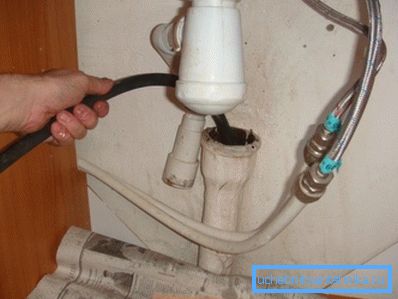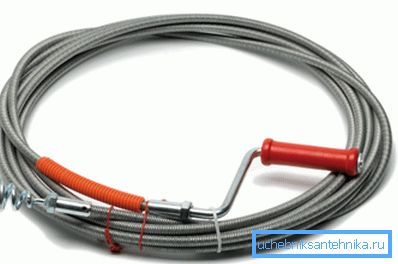Self sewer punching: 3 effective ways
The best indicator of the quality of the sewage system in a residential house or apartment is the complete absence of blockages, which is characterized by rapid discharge of water from all sanitary appliances. If, over time, residents begin to notice that one or more appliances (bath, sink, shower, toilet) let water go too slowly, this means that at some point in the sewer there is a blockage.
Sooner or later, every homeowner faces a similar problem, and then he has a question: how to break through the sewer pipe in an apartment without the help of a professional plumber?

Elimination of blockages in the sewer
In order to help the reader deal with this issue, this article will describe the most common causes of blockages.
Also here will be presented a detailed instruction describing some of the most effective ways to combat this unpleasant phenomenon with the help of household chemicals and plumbing tools.
Causes of blockages
Before you break through the sewers in a private house or apartment in a multi-storey building, you need to understand the mechanics of blockages.
In most cases, the narrowing of the lumen of a sewer pipe can occur for several reasons:
- Violation of SNiP 2.04.01-85 * "Internal water supply and sewerage of buildings" in the design, construction or reconstruction of the building.
- Damage to a hidden or underground collector caused by metal corrosion, limestone deposits, sprouting of tree roots, subsidence of soil, and also inaccurate repair or construction work.
- The accumulation of fat, as well as the deposition of sludge and dirt on the bottom and on the walls of sewer pipes, which over time leads to a significant reduction in the internal cross section.
- The ingestion of foreign objects (rags, coarse debris, municipal solid waste) into the sewer network through the drain holes of plumbing fixtures or the vent hole of the sewer riser.
If in the first and in the second case, to eliminate the problem, you need a complete or partial replacement of the sewer system, then in two other cases any landlord will cope with this problem with his own hands without any help.

Note! All the above recommendations are effective only for cleaning the internal or intra-house sewage system. In the event that a common riser or sewage collector of an apartment building is blocked, it is necessary to contact professional plumbers for help.
Method 1 - Using a Plunger
The simplest household sanitary tool that is found in almost every home is a regular rubber plunger.
Its use is effective for local removal of small debris, sand, earth, toilet paper, etc. from horizontal beds, swivel knees and maintenance-free siphons with a water seal.
- Before using the plunger, you need to take some water into the bath or sink so that it is several centimeters above the level of the drain hole.
- Place a plunger on top of the drain hole and make several sharp reciprocating movements, after which a short sharp movement to tear it from the drain.
- Remove debris from the bath or sink and flush the system with plenty of water. If necessary, repeat the cleaning operation until the sewage blockage is completely eliminated.

Tip! If the garbage contains fatty contaminants, before cleaning with a plunger, it is recommended to heat the blockage site by pouring a large amount of hot water into the drain hole.
Method 2 - chemical means of cleaning
For effective removal of organic pollutants and biological debris (animal and vegetable fat, hair, food debris) special household chemicals are successfully used, which are produced in the form of granular powder, liquid or gel.
Their principle of operation is about the same for everyone, but before breaking through a blockage in the sewage system with a chemical agent, you should carefully read the instructions for use.
- As a rule, a certain amount of this tool should be poured or poured into the drain hole of the sink, and then pour a small amount of hot water there.
- After waiting some time, flush the system with plenty of cold water.
- If the result is unsatisfactory, the same operation can be repeated before the final cleaning.

Tip! In the absence of a special chemical agent, table vinegar and ordinary baking soda can replace it. In the drain hole, you need to pour half a glass of soda, then pour a little hot water, then pour a glass of vinegar into it. An hour after the end of the reaction, flush the system with plenty of cold water.
Method 3 - Plumbing Cable
To remove large debris (rags, scourers, pampers) from vertical risers, swivel knees and horizontal deck chairs, punching sewer blockages with a special rigid sanitary cable with a swivel handle and interchangeable tips is more effective.
- Before using the cable, you must establish the approximate location of the blockage in the sewer system.
- Remove the drain siphon at the nearest plumbing fixture, and on the nearest riser, open the inspection plug, providing access to the pipe from both sides of the blockage.
- Insert the end of the cable into the pipe on one side and move it towards the blockage with a translational-rotational movement.
- If you feel when the cable rests on the likely accumulation of debris, try to hook it with a tip and pull it towards you, or push it towards the revision plug.
In addition to manual cables, there are also models with electric drives, but this is already a professional tool, so the relatively high price does not allow it to be in every home.

Tip! Clearing vertical risers can also be performed through the vent hole of the fan pipe that goes to the roof, or through the lower inspection plug located in the basement of a residential building.
Conclusion
After reading this article, it becomes clear that any home owner will be able to cope with simple household blockages in the sewage system of a residential apartment, without resorting to the help of professional plumbers from the housing department.
To get an answer on how to break through the sewers, you can watch the video in this article or read similar materials on our site.